The Most Uncomfortable—But Necessary—Event In Town Is Brooklyn Transitions: The Gentrification Series!

(Photo: Brooklyn Public Library)
Monday evening the Brooklyn Public Library hosted the first event in an ongoing series on gentrification which includes panel discussions and a project to collect bits of oral history from residents. The several weeks long series is delicately titled, “Brooklyn Transitions.”
Now that gentrification has been overused to the point of becoming a catch-all term to describe a variety of insidious phenomena including the involuntary displacement of longtime residents, it’s evolved into something of dirty word. So, yeah this event could have been interpreted as”uncomfortable” for that reason. But also, it was just super hot in that tiny, packed room.
Despite the fact that people were progressively getting either redder or nakeder, depending on their heat-tolerance, visitors continued to cram into the room throughout the discussion. And it’s hard to blame anyone for their determined interest.
Given controversial “restoration” and “development” projects like the mega-towers sprouting up on the Williamsburg waterfront and the similar future of the Greenpoint waterfront, record breaking sales for brownstones in neighborhoods like Bed-Stuy, and increasing efforts by activists trying to keep their neighborhoods from being overtaken by wealthy developers looking to implant luxury housing in places like Crown Heights, the library probably should have planned for throngs of thousands to attend because clearly many, many people across Brooklyn and the city have a stake in this whole gentrification thing.
True to Brooklyn form, a diverse range of people—including Manhattanites—showed up. There was the middle-aged homeowner from the West Village who acknowledged that yes, white men in athletic shorts do indeed run around her neighborhood (a sure sign of late-stage gentrification), and another woman who declared that rich developers were shortsighted in understanding what actually makes a neighborhood desirable; “I’m not really into consumerism,” she said. We also heard from a young woman and long time resident of Brownsville, who, despite laugher in response to her fears of gentrification, said she adored her neighborhood, a place she felt was “the last ghetto hold out.”
Then there was the real estate industry guy who acknowledged he might be the most hated person in the room because he owns a brownstone in Bed-Stuy that he “could sell for 1 million dollars.” This ultimate bro amongst us managed to at once demonstrate his complete chauvinism and endorsement of money’s agency when he announced that “we live in a capitalistic society; money looks for opportunities everywhere, and that’s never gonna change.” He added: “If you don’t like that then maybe you should move somewhere else.” Several people guffawed.
Three experts led this discussion of gentrification, and presided over the room: Suleiman Osman, an urban historian at Columbia; Sharon Zukin, professor of sociology at CUNY Brooklyn College; and former city planner turned documentary filmmaker, Isabel Hill. They were ostensibly here just to talk about the history of gentrification, but the discussion weighed more heavily on how history has any relevance to what’s happening today, which is a kind of gentrification that Suleiman Osman described as, “a whole different animal.” He proposed that what’s being called gentrification today actually has very little to do with what happened in New York in the 1970s and 80s.
The speed at which neighborhoods reach the fancy-pants threshold (i.e. the point at which the real estate industry can qualify it as “tony”) now is mindboggling, i.e. property values doubling in Bushwick within one year.
In some places like Williamsburg, and especially most of Manhattan, the mega-wealthy are taking the place of the “just” wealthy. The super-rich being those shadowy individuals or corporations with so much IDGAF assets they need creative ways to stash it the world over. And what better place exists than New York City real estate? As of now, there’s still very little regulation governing vacant apartments despite the persistent housing crisis. And, of course, there’s the potential to make massive profits. Think Russian oligarchs, sons and daughters of warlords from a variety of hyper-extractionist failed states, and those creatures with ten valid passports and the ability to slither back and forth over borders at whim.
Does that sound hyperbolic? Ok, maybe. But c’mon, who else could afford a $27 million full-floor apartment at 40 Bond Street in NoHo—a building that most real estate agents familiar with the area will swear up and down is mostly vacant throughout the year—besides a lizard person?
“We are in phase four of gentrification,” and “now, even the gentrifiers [of the early 2000s] are being displaced,” Osman said. “A lot of people and other historians would accuse me of being too simplistic, but I didn’t make these phases up.” He held up his hands in a gesture that basically said, “I know this sucks, I’m sorry—please, please don’t eat me alive.” It’s a motion that’s become familiar amongst academics, politicians, and developers when they gather to discuss gentrification. And really, it’s annoying, particularly among those studying the field. Is it really so risky to stand your ground?
Isabel Hill was a little more willing to point the finger. As a former employee at the Department of City Planning, she witnessed first hand the changes in the city’s attitude towards real estate development of the Brooklyn waterfront from a small manufacturing stronghold to a long stretch of luxury housing with such nice views of Manhattan you can forget you’re in Brooklyn. In fact, she quit her job after the city rejected her recommendations for the waterfront, which were based on the existing community’s wishes, in favor of more moneyed interests.
Zukin agreed that the rezoning and subsequent development of north Brooklyn marked the first time the forces of gentrification operated “outside of the average person’s view.” Many of the changes were invisible until they actually got to the stage of rezoning or public meetings, instead they were confined to back room deals between politicians and the real estate industry.
The night’s discussion offered a few enlightening views on the processes of gentrification, though none of it was particularly groundbreaking, revealing, or controversial. But one glaring problem plagued the panel: the lack of serious discussion about race. The panel members didn’t bring up race in any meaningful way until the very last minute, instead they either touched upon it anecdotally, or let Hill’s characters from her documentary clips do the talking.
When Osman finally did bring up race in his closing remarks, he dismissed it as nothing more than a problematic way of looking at gentrification. “A friend told me gentrification isn’t happening in Portland because everyone is white in Portland,” he chuckled. “And that’s just not true.”
Right, so gentrification isn’t entirely about race; it’s also, and perhaps foremost, a class issue. But in Brooklyn particularly, failing to give race the attention it deserves in the discussion of gentrification, made it seem as though the speakers were avoiding the elephant in the room. For many residents, white people moving into historically black neighborhoods is a much more distinct sign that “change” is on the horizon than say, the opening of a Starbucks.
Admittedly, as the speakers pointed out, drawing up a simplistic racial dichotomy to explain gentrification hinders productive discussion. But that happens when race becomes the only discussion. To get beyond this impasse, race first has to be mentioned and acknowledged—ideally from the get-go—otherwise it’s the old case of “color blindness,” which we all know is total bullshit. Obviously gentrification is about class and money, but to say it’s only—or even mostly—about those things is to downplay the fact that there are still enormous obstacles to socioeconomic equality for people of color in this country. Therefore, a class issue like gentrification, particularly in a place as diverse as Brooklyn, is inextricably tied to race.
“It seems like a countdown to when we have to leave,” the same young woman from Brownsville said. “Is there anything people can do to stay where they are?”
This question came up repeatedly throughout the night, and the solutions arrived at by audience members and the panel alike were community organization and activism. “You have to organize in town hall style meetings and figure out what it is that you want, that’s the first step,” Zukin suggested, before admitting it seems like it’s getting harder and harder for people to “show up” at these community meetings.
What the panel failed to acknowledge however, is that activism and lobbying require a great deal of at least one of two resources—time and money—neither of which poor people have. And increasingly, even the middle class and nominally wealthy people seem to have comparatively less of these resources. Having extra time is a luxury, which is understandably difficult for people who are working one or more jobs with inflexible schedules, and spend their “free time” raising families. Extra time and energy—beyond what a job and other obligations sop up—is needed in order to organize, convene, and lobby their representatives. And then there’s the even more powerful resource of money, which the mega-rich have plenty of to throw around.
Osman summed up the night well with a question that was appropriately left unanswered: “You can’t embalm a neighborhood, but what can you do to make it fair?”
Events for Brooklyn: Transitions continues through December 23rd at the Brooklyn Public Library.
You might also like 



















